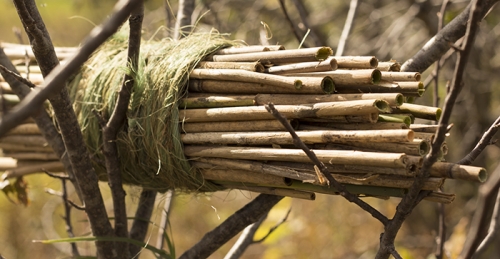Native Pollinators On Farms

Our Projects |
Pesticides |
Native Bees |
Resources |
Education |
|---|
Squash Bees (Peponapis pruinosa)
There is one species of squash bee in Ontario—Peponapis pruinosa. This solitary bee originated in Central America and was naturalized here in Pre-Columbian times following the culture of the “three sisters” by First Nations Peoples northwards along the west coast of North America and then eastwards into present day Ontario and beyond. The squash bee is commonly found on pumpkin/squash farms and in gardens across Ontario, although the northern limits of its range are not known. A specialist on the genus Cucurbita, which includes pumpkin, squash, summer squash, zucchini, and some gourds, the squash bee forages for Cucurbita pollen only and feeds this pollen exclusively to its young. On a seasonal basis, the adult stage of the squash bee life cycle corresponds with the period of time in which Cucurbita crops are in bloom in Ontario. On a daily basis, these bees are active from dawn until noon, corresponding to the time in which Cucurbita crop blossoms, which last only one day, are open. Because of its specialization, its preference for Cucurbita pollen, and the correspondence between flower opening and squash bee activity, the squash bee is uniquely able to pollinate these crops.
Male and female squash bees spend most of their lifecycle as prepupa in underground nests. In June-July (depending on the area in Ontario), they pupate, quickly develop into adults, and emerge from the ground. The next 21 days are spend maturing sexually, followed by mating. This mating happens on Cucurbita flowers and can be observed at the beginning of the Cucurbita flowering season. Once mated, the female squash bee begins to create a nest by tunnelling in the ground. She alternates her activities between nest construction in the afternoons and foraging for nectar and pollen in the mornings when Cucurbita blossoms are open. Male squash bees spend the afternoons sleeping in wilted Cucurbita flowers. Their mornings are spent foraging for nectar and looking for unmated females on open Cucurbita flowers. Males do not actively forage for pollen but they do accidentally move pollen from males Cucurbita flowers to females Cucurbita flowers and so are also pollination agents for these crops.
Although they are solitary bees, meaning each female constructs her own nest without help from others, squash bees are gregarious and will construct their nest tunnels close to each other in aggregations. Managing these nesting aggregations is a crucial part of maintaining strong squash bee populations on farms.
More detailed information about squash bees and managing these bees for pollinating pumpkins, squash, summer squash, zucchini and gourds can be found in Farms at Works’ document Cucurbita Crop Pollination Factsheet.




